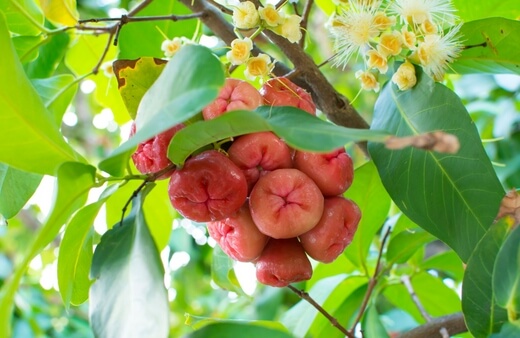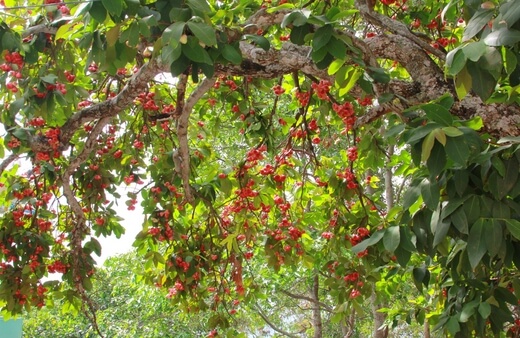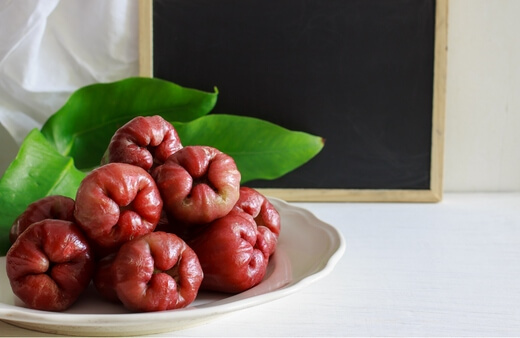I’ve covered many beautiful Syzygium species thus far, most of which are Australian natives but the Rose Apple tree is a fantastic introduced species that can easily be grown in many parts of the country, offering many of the same landscaping advantages to growers.
This ornamental fruiting tree features glossy and glabrous dark-green lanceolate leaves topped with large clusters of fluffy creamy-white flowers in summer. Thereafter, fragrant yellowish fruits form that are also edible, making this plant a great pick for bush food enthusiasts as well.
Here is your comprehensive guide to growing and caring for the rose apple tree.
More...

Family: | Myrtaceae |
|---|---|
Genus: | Syzygium |
Species: | S. jambos |
Common Names: | Rose Apple, Malabar Plum |
Location: | Outdoor |
Type: | Tree |
Growth: | 10 to 12 metres tall and wide |
Sun requirements: | Full sun to half shade |
Foliage Colour: | Green |
Flower Colour: | White |
Flowering: | Summer |
Fruit: | Produces edible yellowish fruits after flowering |
Maintenance level: | Low to medium |
Poisonous for pets: | Entirety of plant is toxic to cats and dogs |
Getting to Know Rose Apple
Rose apple tree is commonly grown in gardens for its ornamental value alone, adorned with flushes of lively red new growth that matures to a glossy green, all of which is elevated by its beautifully rounded crown with a dense habit, perfect for many applications within landscapes.
Syzygium jambos is a species of rose apple that forms a part of the Myrtaceae family and is also commonly known as Malabar Plum. It originates from southeast Asia and now occurs widely in other regions of the globe, including Australia, where it can be found naturalised in coastal districts of Queensland and New South Wales.
This species prefers warm and humid environments, optimal for tropical to subtropical climates wherein it is considered fast-growing and tolerant to a wide range of growing conditions. In these optimised conditions, the tree is rarely without fruits and flowers, offering long-lasting beauty within gardens.
Syzygium jambos Plant Features
The rose apple tree will typically reach around 10 to 12 metres tall and wide. It is important to note that this species is considered invasive in some regions of Australia so be sure to contact your local municipality or agricultural department to see if you can grow this plant in your garden.
The nectar-rich blooms will attract birds, bees and butterflies.
Common Landscaping Applications
- Feature specimen
- Container gardening
- General shrubbery
- Bed filling
- Topiary
- Hedging and screening
How to Grow Rose Apple Tree

Source: Growables
Seeds are the most common means of propagation however the tree can take 5 to 6 years to flower and fruit properly. Propagation using semi-hardwood cuttings is also possible but not always reliable for fruit quality once matured.
As this species is not native to Australia, nursery plants can be hard to come by but they will establish themselves far sooner and with less effort overall.
We recommend growing your rose apple tree from seed or finding and establishing a young and healthy nursery plant for the best results.
Rose Apple Propagation
These seeds have very short viability and no dormancy so it is best to sow them fresh in spring to summer. Seeds can be collected from ripe fruits or purchased online.


Get Your Free Guide:
Master Growing Australian Natives eBook
A Must Have Complete Guide for Every Australian Garden
Get Your Free Guide:
Master Growing Australian Natives eBook
A Must Have Complete Guide for Every Australian Garden
- Surface sow the seeds into seedling containers filled with a high-quality propagation mix.
- Firm them gently into the soil and water well but lightly to avoid washing the seeds away.
- Place the seeds in a semi-shaded location indoors away from strong winds and keep the soil slightly moist.
- A single seed can produce about 3 to 6 seedlings and most of them should be true to type.
- Allow seedlings to develop properly as young plants transplant poorly.
- Pot the seedlings into their own containers once they are large enough and the roots have started developing.
- Only consider transplanting young plants into the garden once they have grown properly in their containers and can handle outdoor conditions.
- Seed germination is usually within 10 to 120 days depending on the conditions.
Best Conditions for Growing Rose Apple
Planting should be done during the tree's active growing season in spring to summer once temperatures have risen and the environment is warm and sunny. These plants can be grown in the garden bed or in containers outdoors.

Best Soil Types
Rich, well-draining soils are preferred but this tree can withstand poorer soils as well. If you have sandy soil, you can doctor it with some compost to enrich it and improve drainage. A neutral soil pH level is recommended.
Sunlight and Exposure
Seedlings and young plants will need shade while they’re establishing themselves. Thereafter, established trees will fruit and flower best in full sun positions. Some afternoon shade shouldn’t be a problem either. Be sure to protect your tree from very strong winds and extended periods of frost.
Ideal Temperature and Humidity
This species can withstand temperatures down to about 0°C. While it will perform best in more tropical regions, it can also grow in cooler coastal conditions.
General garden humidity in tropical and sub-tropical environments should suffice but if you are concerned, consider planting more vegetation around your tree to naturally boost the surrounding humidity.
Tips for Growing Malabar Plum in Pots
Many growers will prefer to keep their trees small. Luckily, these plants do well in pots outdoors. Here are a few quick tips for growing your rose apple tree in pots.
- Start with a pot that is about 50 to 100% larger than the existing root ball of the plant.
- Repot your tree once it has reached its capacity in the current container and move to a larger pot until you reach the desired size.
- Always use a high-quality potting mix and add some fresh soil every time you repot.
- Potted trees may need extra fertilisation to fruit and flower adequately.
- Be sure to always use containers with excellent drainage.
- To improve drainage or to aerate the soil, you can occasionally add some perlite to your potting mix.
- Prune your potted tree as needed to maintain size and shapeliness. Potted plants will require more frequent pruning to stay small.
Caring for Malabar Plum
If the growing conditions are favourable, plant care and maintenance should be minimal overall. Young plants will require a little more effort but once established, these trees tend to do well on their own.

Water and Moisture Needs
While this tree can withstand semi-arid conditions, prolonged dry spells can be detrimental. In the warmer months, water frequently and deeply if rainfall is minimal to keep the soil slightly moist.
You can keep the soil drier in the colder months. Be sure to avoid overwatering and soggy soil.
Mulching
Keep your tree well mulched in summer to assist with proper moisture retention. An organic mulch will ensure healthy flowers and fruits.
Related: Best Types of Mulch for the Garden
Fertilising
Feed with an organic fertiliser or blood and bone every spring to encourage growth and assist with fruiting and flowering. Be sure to delay harvests after fertilising for about 7 days.
Pruning
This plant responds very well to clipping, especially while young. If you desire, you can prune to use the tree as a hedge or screen in your garden. Be sure to always prune after flowering and remove any spent flowers, dead stems and old foliage.
It is also advised to maintain a good pruning routine while your tree is growing to establish a balanced canopy and to ensure a suitable branching framework.
Clean-Up
Dropped fruits and old flowers can cause some mess within gardens. After flowering each season, you may need to perform some general clean-up on the ground around your tree to remove fallen fruits, flowers, foliage and stems.
Rose Apple Bush Tucker Guide
The unique fruits of the rose apple tree are commonly mistaken as guavas based on their shape and appearance. What sets them apart is their distinctive fragrance, flavour and texture which is very different to guava.
In ideal conditions, these trees can fruit for months on end, offering growers a stable supply of ripe fruits as they need. The ripened fruits have thin and waxy skin, maturing into a yellowish-green colour.
They feature a strong yet pleasant floral scent with flavours very similar to rose water, hence the common name. The fruits boast a deliciously crisp and watery texture, perfect for summertime snacking.
Overall, the nutrient value of these fruits is considered low compared to other fruits but they are rich in vitamins A and C, have a low caloric value, and contain some essential iron and calcium along with other micronutrients.

Harvesting Rose Apples
- Typically, the fruits should ripen about 4 months after flowering.
- Yields can be low if moisture and sunlight are not optimal but should increase slowly over the seasons with some adjustments.
- Traditionally, the fruits were shaken to see if the seeds rattled inside. This would give a good indication of whether they were ripe or not.
- Ripe rose apples will lose the last traces of their green background colour and develop into a full bright yellowy colour.
- Ripe fruits will also have white or cream-coloured flesh inside whereas young, undeveloped fruit flesh is green.
- Harvest by gently plucking ripened fruits straight from the tree branches.
How to Use Rose Apples
These fruits can be enjoyed raw or cooked. The inner fluff of the fruits can be scraped out, leaving the edible skin and flesh. It is always best to rinse fruits before consumption to remove any dirt and debris.
Eaten fresh, the fruits will showcase their delicate and sweet rose-like flavours which can be enjoyed out-of-hand as a lovely low-calorie snack.
Alternatively, many choose to cook the fruits into processed jams and jellies thanks to the high levels of pectin which offers excellent setting qualities.
Here are some other common culinary applications for rose apples:
- The fruits can be brandied or candied for a sweeter flavour for desserts.
- They can be stewed and used to enhance dips and sauces.
- Fresh fruits look fantastic on fruit platters or sliced and tossed into salads.
- The fruits taste great when lightly stir-fried into rice-based dishes or stuffed with meat and baked in sauces for added flavour.
- Rose apples pair very well with cinnamon, sugar, tropical fruits, tomatoes, garlic, peppers and meats like fish and poultry.
It is important to note that these fruits do not store well and they will go bad within days of harvesting. Be sure to use the fruits straight away for the tastiest and plumpest experience.
They can be refrigerated for about 2 to 4 days but bruise easily so immediate use is recommended whether enjoyed fresh or cooked.
There are no set rules for using rose apples so be sure to get creative and find the best ways to enjoy them for you and your family. As with any bush food, being conscious of maintaining a safe intake quantity is always advised.
Syzygium jambos Pests, Problems and Diseases
Unfortunately, this species is sometimes susceptible to issues that plague other members of its family. While some problems can be controlled, others may require more time and effort.
Myrtle Rust
This disease can pose a big problem for rose apple trees and severe infection can require continuous control. Rust appears as tiny yellow spores on the undersides of leaves that will eventually spread and start forming larger spores on plant matter.
Unfortunately, there is no current cure for this disease so the best thing to do is to remove infected plants to avoid the rust from spreading to other trees and nearby vegetation.
Psyllids and Aphids
Psyllids and aphids appear as small blob-like markings on leaves and stems. Psyllids are a whitish colour whereas aphids are reddish-brown. These pesky pests can be eliminated by treating your tree with an organic horticultural oil or organic neem oil spray in spring which will kill off overwintering adults and eggs.
Fruit Flies
Ripe and overly ripened fruits can attract fruit flies in warmer conditions and certain regions. Many common control methods include laying traps around the garden, using preventative netting or using specialised fruit fly control products.
Here is our guide for more information:
Rose Apple Frequently Asked Questions

What does a rose apple taste like?
Rose apples are light and crunchy in texture, presenting an initially sweet and fruity flavour followed by floral notes of rose.
Why is it called a rose apple?
The pulp of the fruit shares a similar consistency to that of a crunchy apple with a rose-like scent.
Where are rose apples found?
The plant is native to the East Indies and Malaysia but is now found in tropical and sub-tropical regions globally.
How long does a rose apple take to fruit?
On average these trees take about 3 to 5 years to fruit after planting.
Can you grow rose apples at home?
Yes, the seeds from ripe fruits can be used for propagation and planting.
Does rose apple cause coughing?
Overconsumption can lead to an itchy throat and coughing in sensitive individuals. Be sure to always limit intake when consuming any bush food.
Is rose apples good for weight loss?
Rose apples are a great low-calorie fruit option that is rich in dietary fibre which can help regulate blood sugar levels and assist with weight management.
Is Syzygium jambos fast-growing?
In ideal conditions, this tree is considered fast-growing, making for an excellent hedge or screen as well. Healthy growth is around 2 metres a year.
Interested in growing fruiting Syzygium natives? Here are a few gorgeous species to choose from for your garden:
Wrapping Up Our Rose Apple Tree Guide
So, there you have it, another spectacular Syzygium species to consider growing in your garden, the rose apple tree. Whether purely for its ornamental value or its palatable fruits, this evergreen tree can quickly elevate your outdoor spaces with its exciting new growth, dense glossy foliage and creamy-white powder puff flowers, regardless of how it is used.
Provide your rose apple tree with some basic care and attention and you’ll have long-lasting beauty influencing your landscape for years to come.
Published on February 9, 2023 by Nathan Schwartz
Last Updated on February 23, 2024




